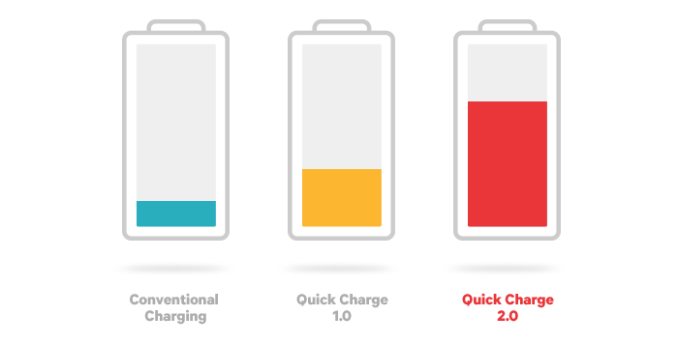Qualcomm Announces Quick Charge 3.0: Intelligent Voltage Control
by Joshua Ho on September 15, 2015 1:41 AM EST- Posted in
- Mobile
- Qualcomm
- SoCs
- Snapdragon 820
- Snapdragon 617
- Snapdragon 430

One of the other features that was announced for multiple Snapdragon SoCs at the 3G/LTE Summit in Hong Kong was Quick Charge 3.0, which will be supported on the Snapdragon 820, 617, and 430.
The latest iteration of Qualcomm's rapid charging technology, Quick Charge 3.0 is said to enable up to 27% faster charging over QC 2.0 or up to 38% more efficient. Relative to QC 1.0, charge speed doubles. This is done by using an algorithm that Qualcomm calls Intelligent Negotiation for Optimum Voltage, which allows for selection of appropriate voltage for various device states while charging. Rather than a number of fixed voltage settings, QC 3.0 can scale from 3.6 to 20V in 200 mV increments and will work over USB, including new connector designs like USB Type-C as the USB protocol is not the same as physical connector design. QC 3.0 will be available for vendors to implement now, and it’s likely that we’ll see phones with support for this new fast charging standard appear early next year.
Source: Qualcomm










27 Comments
View All Comments
edzieba - Tuesday, September 15, 2015 - link
Sounds almost like moving the charge controller from the battery package to the charger (or rather, overriding the charge controller in the pack when using a compatible charger). Could make the use of poor quality chargers even more dangerous if it's implemented wrong: an unscrupulous manufacturer could decide "let's ramp up to 20V faster for longer, because more volts means faster charging!" and cause battery fires. Sure, no Qualcom certified charger would do this, but it's not the certified chargers that are the problem.Maybe Qualcom is doing some secure handshaking with a 'certified' charge controller before allowing the voltage control to be handed off the the charger, but that sounds like even more of a pain than the MFI program.
aakash_sin - Tuesday, September 15, 2015 - link
+1kspirit - Tuesday, September 15, 2015 - link
Your comments makes a scary amount of sense. Another +1extide - Tuesday, September 15, 2015 - link
No there will always be a pack level protection circuit, and a phone level charge controller on top of this. If the voltage goes outside of spec it will just stop charging. I mean this is going to be one of the first considerations in the design of ALL of these components. Not an issue.toyotabedzrock - Tuesday, September 15, 2015 - link
That would be nice if manufacturers like LG didn't refuse to sell batteries to technically skilled people and instead leave us to try and hope that guy on Amazon or EBAY actually is selling an OEM part.extide - Tuesday, September 15, 2015 - link
Yeah that stuff you buy on ebay/amazon is not going to be OEM but I have bought lots of those cheapo replacement batteries and so far have never seen one without a protection circuit inside the battery itself.III-V - Wednesday, September 16, 2015 - link
I repair cell phones for a living. Neither Ebay nor Amazon is where you should be looking for OEM parts -- that's where you look for bottom of the barrel garbage, because you value paying somewhat less over having a quality part.Use a dedicated cell phone part place like ETrade Supply. You pay more, but you'll actually get decent stuff.
DanNeely - Tuesday, September 15, 2015 - link
Fortunately control remains with the device being charged not the power brick. From Qualcomm's press release (linked at the foot of the article):How does it work? Quick Charge 3.0 employs Intelligent Negotiation for Optimum Voltage (INOV), an algorithm which allows your portable device to determine what power level to request at any point in time, enabling optimum power transfer while maximizing efficiency.
JKJK - Tuesday, September 15, 2015 - link
It took like forever from quick charge 2.0 was implemented in phones to chargers was actually on the market. I hope the timing is better this time.aryonoco - Tuesday, September 15, 2015 - link
Someone needs to do some proper tests to see the effects of all these quick charging on battery's longevity.